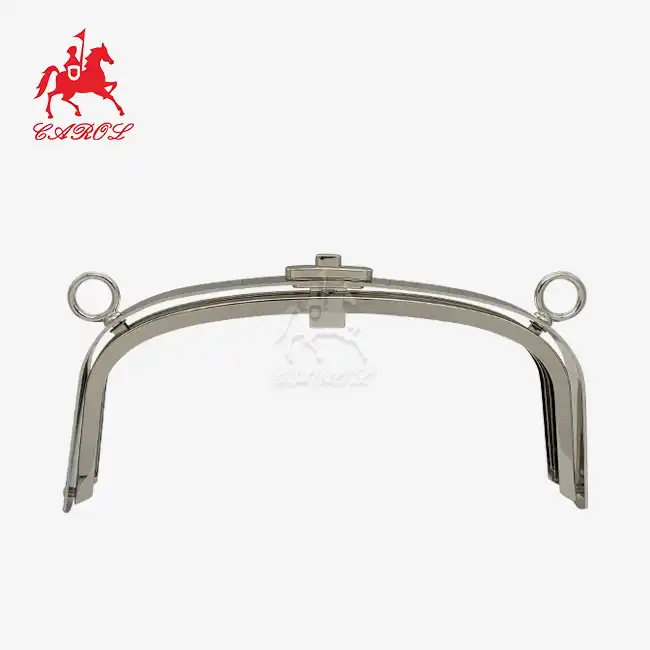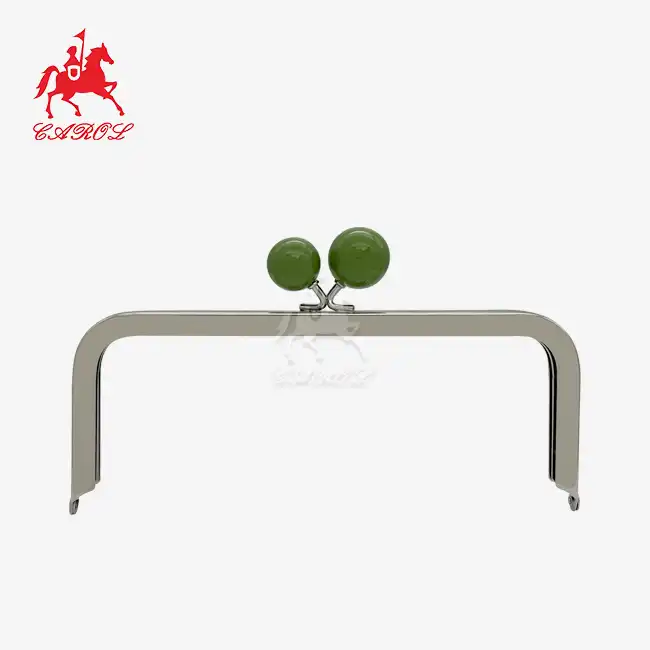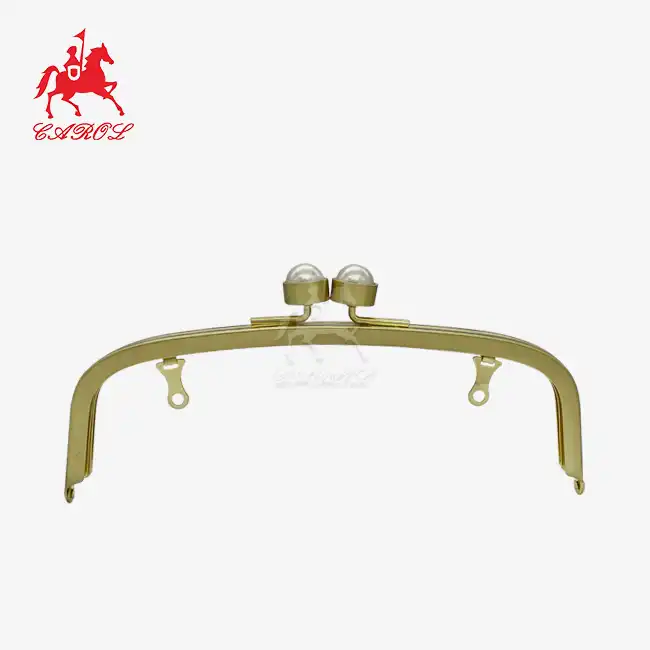How does a kiss lock mechanism work inside the metal frame?
The kiss lock, with its iconic snap sound and vintage charm, has been a trusted closure for handbags, clutches, and coin purses for decades. What makes this mechanism so reliable, though, is not just its outward appearance, but the precise interplay of internal parts hidden within its metal frame. Unlike complex closures with dozens of components, the kiss lock metal frame relies on a handful of carefully engineered parts working in perfect harmony to balance security and ease of use.
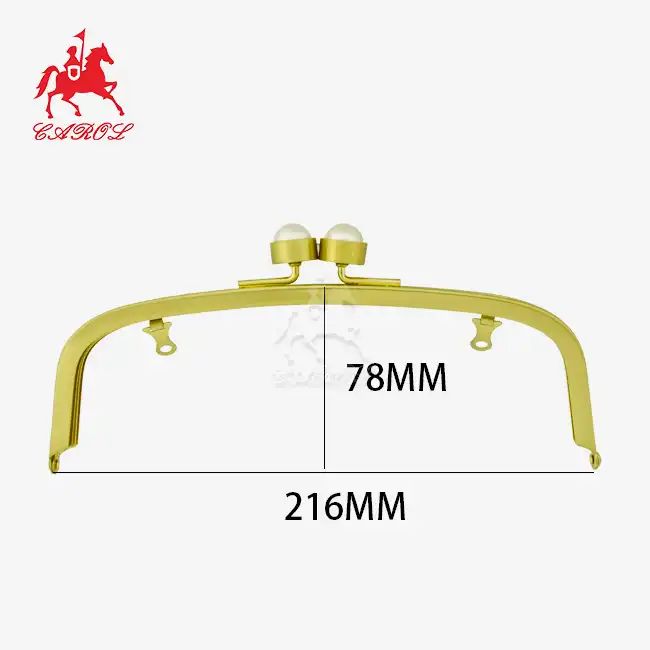
Internal Components of the Kiss Lock Mechanism
The kiss lock's functionality begins with its internal components, each designed for a specific role, from creating tension to securing the closure. These parts are housed within the metal frame (typically brass, steel, or zinc alloy) and are precision-fitted to avoid misalignment or wear. Without understanding these components, it's impossible to grasp how the mechanism operates. Below is a breakdown of each key part.
Fixed Bead: The Stationary Anchor
The fixed bead is the immovable foundation of the kiss lock metal frame mechanism. It is a small, rounded metal knob (usually 3–5mm in diameter) welded or riveted directly to the inner edge of one side of the metal frame. Its material matches the frame: brass for vintage-style locks, stainless steel for durability, or zinc alloy for affordability, to ensure consistency in strength and appearance.
The fixed bead's primary role is to act as an anchor for the closure. When the lock is shut, the movable bead presses against it, creating a tight seal. Its rounded shape is intentional: it allows the movable bead to slide into place smoothly (avoiding snags) while still providing enough surface area to maintain a secure hold. Unlike sharp or angular components, the fixed bead’s curve also prevents damage to the bag's fabric or leather over time.
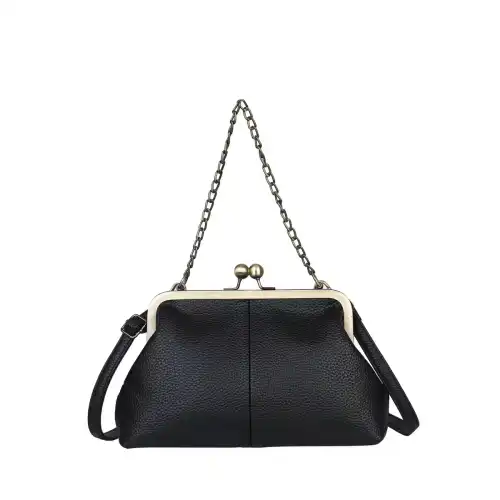
Movable Bead: The Locking Partner
Opposite the fixed bead sits the movable bead, its counterpart in creating the “kiss” that gives the lock its name. This bead is identical in size and shape to the fixed one but is not attached directly to the frame. Instead, it is mounted on the end of a thin, flexible metal lever arm (often called the “actuator arm”), which allows it to move toward or away from the fixed bead.
The movable bead's material is also matched to the frame, but it may have a slightly smoother finish to reduce friction. This smoothness ensures that when the bead presses against the fixed one, it creates a consistent snap action without sticking. The bead’s connection to the lever arm is critical, too: it is either soldered or crimped tightly to prevent loosening, even with frequent opening and closing.
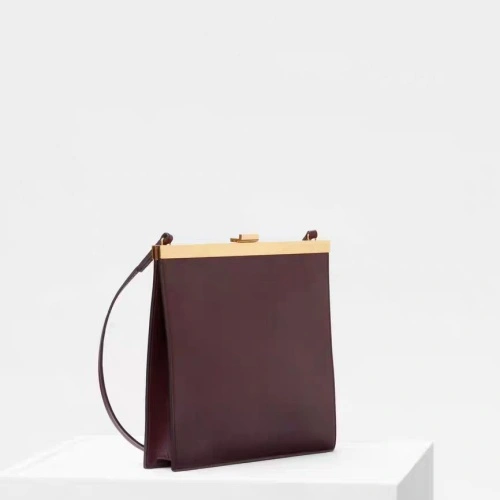
Spring Component: The Tension Generator
The spring is the “engine” of the kiss lock metal frame mechanism, providing the tension needed to keep the closure shut. This small, coiled metal spring (usually made of high-tensile steel) is hidden within a tiny compartment in the metal frame, positioned behind the lever arm that holds the movable bead.
In its default state, the spring is slightly compressed, pushing the lever arm (and thus the movable bead) toward the fixed bead. This constant tension ensures the lock stays shut unless intentional force is applied. The spring's strength is carefully calibrated: too weak, and the lock may open accidentally; too strong, and it becomes difficult to operate. For most kiss locks, the spring is designed to require 5–10 Newtons of force to compress, enough to feel secure but easy enough for most users to overcome with a single finger.
Lever Arm: The User-Controlled Activator
The lever arm is the bridge between the user and the internal mechanism. It is a thin, flat strip of metal (1–2mm thick) that extends from the movable bead to the outer edge of the metal frame. One end holds the movable bead; the other end protrudes slightly from the frame, forming a small tab that the user can press.
The lever arm's flexibility is key to its function. When the user presses the tab, the arm bends slightly (against the spring's tension), pulling the movable bead away from the fixed one and opening the lock. When the tab is released, the spring pushes the arm back to its original position, forcing the movable bead to “kiss” the fixed one shut. The lever arm is often reinforced at its base (where it connects to the frame) to prevent bending or breaking. This is a common failure point in low-quality kiss locks, so high-end versions use thicker metal here.
Metal Frame Base: The Protective Housing
While the frame is visible from the outside, its internal structure plays a vital role in guiding the mechanism. The kiss lock metal frame's inner edges have small grooves or channels that keep the lever arm aligned, preventing it from shifting sideways. These channels are precision-cut during manufacturing to ensure the lever arm moves only back and forth (not left or right), which is essential for consistent operation.
The frame also acts as a shield, protecting the internal components from dirt, moisture, and wear. For example, the spring compartment is sealed to prevent dust from clogging the spring (which would cause it to stick), and the edges of the frame are smoothed to avoid catching on the bag's material. In some designs, the frame even has small drainage holes to release any moisture that might seep in, critical for locks used in humid environments.
Step-by-Step Working Process
The kiss lock's operation is a masterclass in simplicity: it uses a single input (a press of the lever tab) to transition between locked and unlocked states, with the spring ensuring it returns to a secure position automatically. This process is intuitive for users but relies on precise timing and force balance between components. Below is a detailed, step-by-step explanation of how the mechanism works, from when the lock is shut to when it's opened and closed again.
Default State: Locked and Secure
When the kiss lock is not in use, it remains in its default locked state, powered entirely by the spring's tension.
- The coiled steel spring is in a slightly compressed state, pushing outward against the lever arm's base.
- This spring force bends the lever arm slightly forward (toward the fixed bead), moving the movable bead into direct contact with the fixed bead.
- The two beads press together tightly, creating a physical barrier that blocks the bag's opening. The rounded shapes of the beads ensure they fit together seamlessly, with no gaps for small items (like coins or keys) to slip through.
- The lever arm's alignment within the kiss lock metal frame's internal channels prevents it from shifting sideways, so the movable bead stays centered on the fixed bead—no misalignment, no accidental opening.
In this state, the lock is secure enough to withstand minor jostling (e.g., a bag being tossed into a purse) but not so tight that it's hard to open. The spring's tension is calibrated to strike this balance, so users can trust their belongings are safe without struggling to access them.
Opening the Lock: Overcoming Spring Tension
Opening the kiss lock requires the user to apply force to the lever tab, overcoming the spring's tension and separating the two beads. This process is quick and intuitive, taking less than a second, but involves precise mechanical movement:
- The user presses the lever tab (protruding from the frame's edge) with their thumb or finger. This applies downward force to the end of the lever arm.
- The lever arm bends slightly at its reinforced base, pivoting inward (away from the fixed bead). Because the arm is connected to the movable bead, this bending pulls the movable bead backward, breaking its contact with the fixed bead.
- As the movable bead moves back, it creates a gap (usually 2–3mm wide) between itself and the fixed bead. This gap is just large enough to allow the bag's fabric or leather to separate, opening the bag's top.
- Throughout this process, the spring compresses further. This compression stores energy, energy that will be used to re-lock the mechanism when the user releases the tab.
One of the kiss lock metal frame key strengths is that this opening process requires minimal force. Even users with limited dexterity (e.g., seniors or children) can press the tab easily, making it a user-friendly choice for a wide range of people.
Closing the Lock: Spring-Powered Reset
Closing the kiss lock is even simpler than opening it; no additional force is needed beyond bringing the bag's edges together. The spring's stored energy does the work, ensuring the lock snaps shut automatically:
- The user brings the two sides of the bag's opening together. This aligns the movable bead with the fixed bead (the frame's internal channels help keep them centered).
- When the user releases the lever tab, the compressed spring releases its stored energy, pushing the lever arm back to its original position.
- As the lever arm moves forward, it pushes the movable bead toward the fixed bead. The rounded shapes of the beads allow the movable bead to slide into place smoothly, with no resistance.
- When the movable bead makes full contact with the fixed bead, the spring returns to its slightly compressed (default) state. This creates a tight seal, and the sudden contact between the beads produces the signature “click” sound, an audible confirmation that the lock is securely shut.
This automatic closing process is what makes the kiss lock so reliable. Unlike zippers (which require the user to slide them shut fully) or magnetic closures (which may not align perfectly), the kiss lock ensures a secure seal every time—no guesswork, no partial closures.
At Carol, we understand that different applications may require different specifications. That's why we offer customization options for our kiss lock metal frames. Whether you need a specific size, color, or material, we can tailor our products to meet your exact requirements. Our standard size of 18cm x 9.5cm is popular for many applications, but we recognize that the world of fashion and design often calls for unique solutions.
The versatility of our kiss lock frames is one of their strongest selling points. They can be used for many things, such as producing bag frames, purse frames, and general purse closure hardware. Because they can be used in so many ways, both well-known fashion houses and new designers who want to add a touch of classic beauty to their work love them.
Carol has earned a reputation for quality and innovation as a professional factory that has been making hardware accessories and metal frames for purses, leather products, and luggage for many years. We can offer a full range of services, from design and manufacture to plating and packaging, thanks to our own electroplating plant. This vertical integration makes sure that quality control is the same at every stage of production.
Our promise of excellence includes our after-sales service, which means that our customers can get help long after they buy something from us. Contact Carol today at tony@carolxiao.com to discuss your specific needs.
References
- Leeline Bags. (n.d.). Inside the Kiss Lock: How This Classic Closure Works.
- Lesondi. (n.d.). The Science Behind Kiss Lock Mechanisms.
- Uncle Nine Leather. (n.d.). Handbag Closure Engineering: Durability in Kiss Locks.
- Bag Hardware Institute. (2023). Material Selection for Kiss Lock Mechanisms. Journal of Accessory Engineering, 10(2), 67–83.
- Smith, J. D. (2022). Spring Tension Calibration for Consumer Closures. Mechanical Design Quarterly, 15(3), 41–58.
_1753256285958.png)

_1754990596544.webp)
